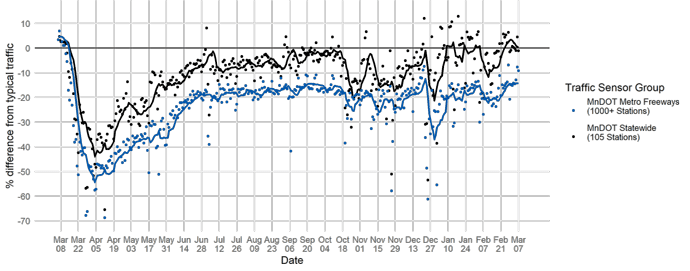Our analysis of traffic data during the COVID-19 Pandemic showed that Minnesotans reduced their travel rapidly in the days following the first COVID-19 case in Minnesota, with a slow and steady rebound to near-typical levels by the following year. This graph shows the daily relative decrease in travel over time across the Twin Cities’ metro area freeways (blue dots and lines) and on traffic sensors placed primarily outside the metro area (black dots and lines) for the period between March 1, 2020 and March 1, 2021. Points that fall below the zero-line represent decreases in travel relative to typical travel on that day of the year and day of the week.
 A line graph of traffic volumes relative to typical traffic (the horizontal line at zero). The blue line shows traffic trends for the metro area freeway system. The black line shows traffic trends on the MnDOT Automated Traffic Recorder System. Metro area traffic was consistently more reduced than statewide averages throughout the COVID-19 Pandemic.
A line graph of traffic volumes relative to typical traffic (the horizontal line at zero). The blue line shows traffic trends for the metro area freeway system. The black line shows traffic trends on the MnDOT Automated Traffic Recorder System. Metro area traffic was consistently more reduced than statewide averages throughout the COVID-19 Pandemic.
In the two weeks before the stay-at-home order was put in place on March 28, traffic volumes plummeted. Travel across the region’s freeways declined by up to 70% in mid-March 2020. By the time the stay-at-home order was lifted on May 18, 2020, freeway traffic was only 32% below typical levels.
Data also show how weather plays a part in residents’ decision whether to travel, especially on weekends. This is most clear on April 27, 2020 when an Easter Sunday snowstorm dropped traffic 71%, lower even than when the Governor issued the stay-at-home order. Heavy rain has had a similar effect as seen on May 17 when a spring storm dumped over two inches of rain in the metro area.